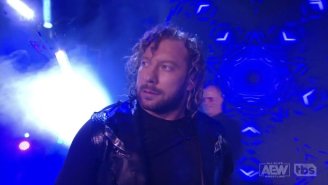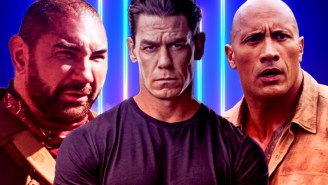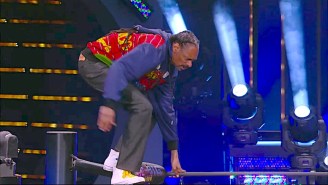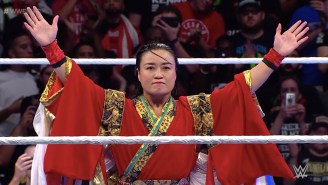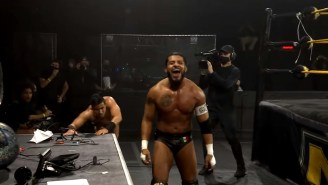Wrestling is a tough job, but somebody’s inspired to do it. Joe Keatinge (Shutter, Glory) and new artist Nick Barber take on the day-to-day life of the men and women who put on the greatest events in the ring in their new series Ringside. They sat down with us to talk about the quiet drama behind the scenes that powers the enormous drama in the ring.
How did Ringside come together?
Nick Barber: This project was starting coming together when Joe saw my art online. This is my first professional comic, so I was totally unknown. We started talking on Skype about collaborating on something together. When Joe asked me what kind of comic I wanted to draw, I said I’d like to do something in the vein of a Michael Mann movie — particularly Thief. Ringside was a pitch Joe had been working on previously in a slightly different form from what it became. The tone seemed to be a perfect fit what we both wanted to do. At that time, I was working as an animator in Japan. This seemed like a really exciting opportunity, though, so I came back to New Zealand (where I’m from) to start work on it.
Joe Keatinge: I did a series at Image called Shutter and I wanted it to be the complete opposite. Shutter is very fantastical and Ringside is a quiet drama. I met Nick, and I thought he could pull off the quiet drama really well.
How do you approach drama as an artist compared to a typical action book?
Barber: Yeah, the quiet stuff can be hard. I just try to ‘feel’ it as I draw it — put myself in the head of the character when they’re in that moment. Drama is probably what I enjoy more. It was more my strength over action as an animator also. Growing up, I really liked Adrian Tomine comics. He’s exceptionally good at those quiet moments. It’s really big in manga, too, several panels of a character processing a thought or emotion — I love that stuff.
Keatinge: There’s a lot of pre-planning. It’s very methodical: What’s happening in the scene? What kind of action are they doing? What does that say about character? The biggest thing is making sure that more so than showing off the research, it’s about creating a level of empathy. Whether it’s big or two old wrestlers driving around in a car. As long as it gives empathy, I think you can do a lot. I love slow burn fiction, whether it’s novels or comics, more character-focused and subdued.
One vivid thing about the book is the faces you draw. Could you talk a bit about your process there, how you “design” a person so to speak and think about their reactions?
Barber: As far as design, I just go by how Joe describes a character in the script. I will picture them in my head as I read it, then just draw them in the layout — usually they will appear pretty clearly by the last page of layout. The designs kind of evolve though, I don’t think the characters look exactly the same all the time… I try to just draw the right ‘performance’ over anything else and let the characters take shape the way they want to. I hate model sheets for character designs; they’re too rigid. I’d prefer it to be more organic — there’s a thing I read once from John Kricfalusi where he said on Ren & Stimpy, he didn’t want to see the same facial expression twice on those characters — which is pretty incredible.
How much research did you need to do for Ringside?
Barber: I watched a lot of documentaries about wrestling which helped prepare for Ringside. But most of the visuals just come from finding and taking reference photos – just the usual reference comic artists use. Joe’s really specific in describing the environments for instance, so it’s fairly easy to get the right feel for those. My style isn’t ‘realistic,’ though, so there’s a lot of room to draw things without too much research.
Keatinge: A lot! Some of it is in a sense my whole life. I’ve always been into professional wrestling, Mick Foley’s novels got me into the behind-the-scenes stuff. That there’s real men and women putting their lives on the line. I’ve talked with people. There’s such a great amount of material, podcasts like Steve Austin’s, and David Shoemaker’s writing on wrestling. In Ringside, the themes are things people can relate to. The wrestling is secondary to the character stuff.
The book is filled with specific personalities and personas. Was that at the beginning or has it grown as you’ve worked on the book?
Keatinge: Every project I work on has its own separate notebook. When I start a new project, the first notebook is backstory shit. I have a whole notebook about Dan, when he was born, when he was exposed to wrestling. It never may make it into the comic, but you build it out initially, give little details here and there. I just want wrestling represented: Andre is a loudmouth representative type, Dan is a C-card heel. It took a lot of pre-planning.
When you’re working on inking and coloring, what’s your approach to balancing the two?
Barber: Simon Gough is the colorist on the book and Ariana Maher is the letterer — it was important to get everyone on the same page style wise, as the art in Ringside is intentionally very crude and rough around the edges. I think we did a really good job of that. Some comics can be just everyone doing their own thing and it doesn’t feel cohesive, like a band all playing out of time with each other. I hate seeing that, like when the colors just don’t fit the art style. I think it was a struggle at first for Simon as he’s used to doing very detailed, rendered coloring. It’s surprisingly hard in art to do ‘less.’ But we managed to sync up really well. Same thing with the lettering, often comics just go to a default lettering look, but Ariana made an amazing effort finding a look that complimented the style of Ringside. The comic wouldn’t be anywhere near as good without our whole team, to be completely honest.
Another shared question: Who’s your favorite wrestler/what’s your favorite wrestling moment, and why?
Barber: My favorite wrestler is The Minotaur!
Keatinge: Mick Foley is my all-time favorite, CM Punk is a close second, Kevin Owens is my contemporary favorite, and they all know how to tell a story. Who Mick Foley was, was retained throughout all those personas. Punk and Owens, they’re not just some guy in the ring, they know how to stage a match to convey a drama really well. If you look at the rivalry between Foley and Undertaker, it’s such a well-choreographed and well-staged work, it’s astonishing.
And on that note, let’s check out some pages from Ringside‘s second issue. Issue #1 will be available in stores and digitally this Wednesday.

